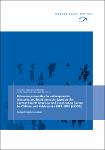Reference percentiles for anthropometric measures and blood pressure based on the German Health Interview and Examination Survey for Children and Adolesce [KiGGS - Kinder- und Jugendgesundheitsstudie, 2011]
Neuhauser, Hannelore
Schienkiewitz, Anja
Rosario, Angelika Schaffrath
Dortschy, Reinhard
Kurth, Bärbel-Maria
Growth charts are key instruments for monitoring growth in infants, children and adolescents and for identifying potential health or nutritional problems. Percentile curves are used to track the growth of individual children compared to the distribution of body measurements in a reference population. The National Health Interview and Examination Survey for Children and Adolescents (KiGGS) 2003 to 2006 is a milestone in improving the availability of data on the health on children and adolescents in Germany. This volume contains KiGGS reference percentiles for blood pressure and various body measurements: length/height, body weight, body mass index (BMI), waist circumference, hip circumference, waist-to-hipratio (WHR), waist-to-height-ratio (WHtR), skin fold thickness, estimates of total body fat, as well as head circumference. The percentile curves and reference tables are based on standardised measurements of children and adolescents aged 3 months to 17 years who participated in the KiGGS 2003 to 2006 study. The strengths of the KiGGS reference percentiles include the nationally representative and large sample, an even representation of all age groups from 0 up to under 18 years for boys and girls, the standardisation of measurements and the use of modern statistical methods. Only very few children under the age of 3 months participated in KiGGS. However, percentiles are needed in clinical practice from birth onwards. Therefore, KiGGS data have been supplemented by birth data (perinatal survey 1995 to 2000) and missing data points have been interpolated.
No license information

